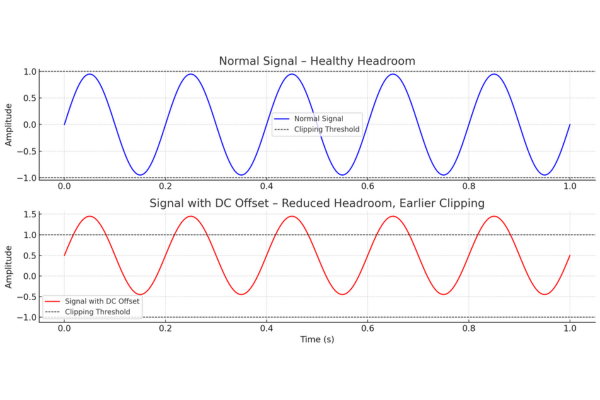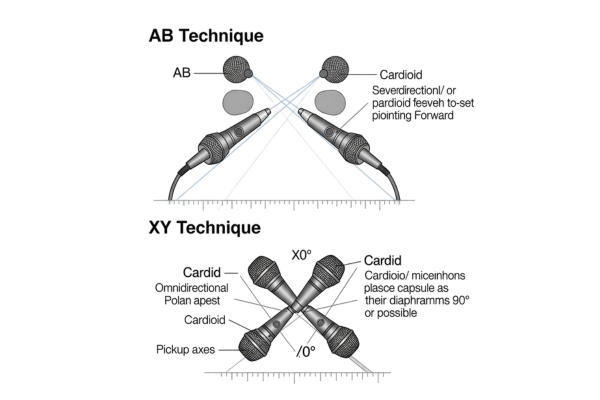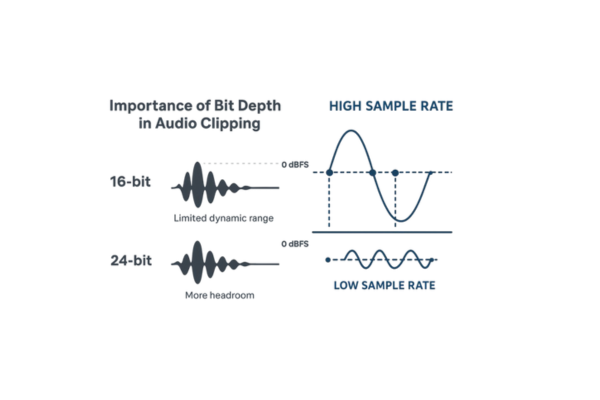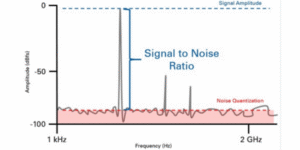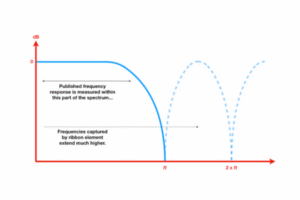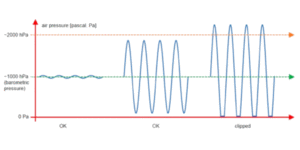in the domain of Audio Post Production, what if i say, in audio recording and sound design, clarity is everything. Whether you’re recording a voice-over, capturing the ambience of a forest, or mixing vocals for a hit song, one technical specification you cannot afford to ignore is the Signal-to-Noise Ratio (SNR) of your microphone.
But what exactly is SNR, and why does it matter so much in audio production?
Table of Contents
What is Signal-to-Noise Ratio?
Signal-to-Noise Ratio (SNR) is a measurement that compares the level of the desired audio signal (your voice, an instrument, etc.) to the level of background noise produced by the microphone itself.
It is expressed in decibels (dB).
The Formula:
SNR = Signal Level (dB SPL) - Self-Noise Level (dB SPL)
The higher the SNR, the cleaner and more professional the recording will sound.
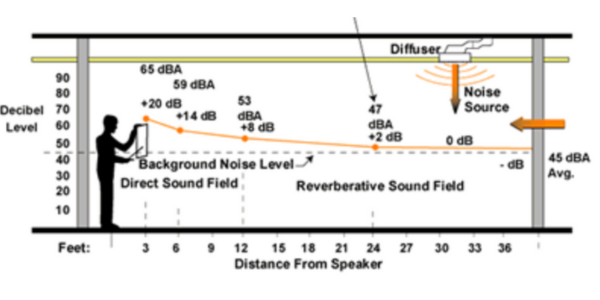
Understanding Self-Noise
All microphones produce a small amount of electrical noise due to their internal components—this is called self-noise. Even in a perfectly silent room, this noise can be picked up during recording.
For example:
- A microphone might generate a self-noise level of 12 dB SPL.
- If it’s designed to capture signals up to 94 dB SPL,
- Then its SNR = 94 – 12 = 82 dB, which is excellent.
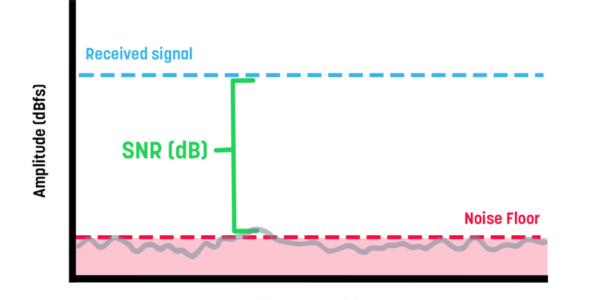
Why is SNR Important?
A high signal-to-noise ratio ensures that the microphone captures your intended sound clearly, without being masked or polluted by its own internal hiss or hum.
Affects:
- Speech intelligibility in podcasts and broadcasts
- Dynamic range in music recording
- Detail and realism in field recording and Foley
- Post-production flexibility (less noise to clean up)
What is a Good SNR?
| Microphone Quality | Typical SNR Range | Use Case |
| Entry-Level | 60–70 dB | Basic home recordings |
| Mid-Range Studio Mics | 75–85 dB | Voice-over, music, content |
| Professional Mics | 85–95+ dB | Film, broadcast, studio sessions |
A microphone with an SNR of 80 dB or higher is considered high quality for most professional applications.
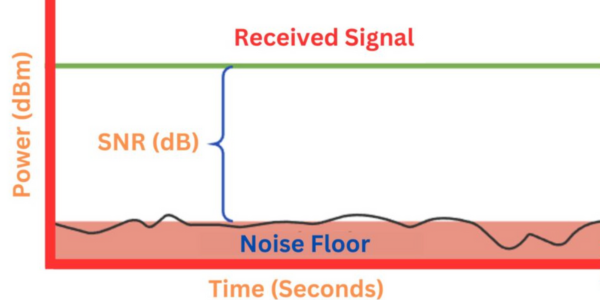
SNR vs. Other Specs
While SNR is important, it’s best assessed alongside other microphone specs:
- Frequency response
- Polar pattern
- Max SPL
- THD (Total Harmonic Distortion)
But when it comes to clarity and noise control, SNR plays a crucial role.
Real-World Tips
- Use High-SNR Microphones when recording quiet sources or detailed ambience.
- Match Mic to Environment – Even the best SNR won’t help if your space is noisy.
- Pair with Clean Preamps – Low-noise signal chains preserve SNR benefits.
- Check Manufacturer Specs – Look for “Self-Noise” and “SNR” ratings before purchase.
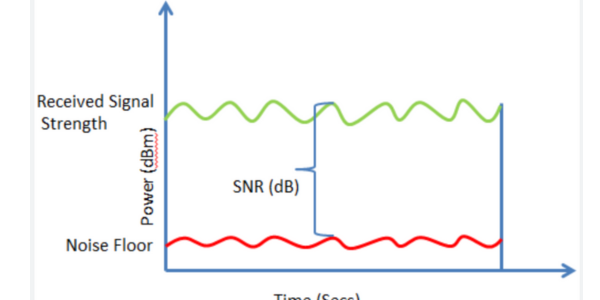
In audio recording, what you don’t hear is just as important as what you do. The signal-to-noise ratio in microphones directly influences the purity and quality of your recordings. Whether you’re an aspiring podcaster, an indie filmmaker, or a seasoned sound engineer, understanding and prioritizing SNR will elevate the sound of your work.
🎙️ Choose a microphone with a high SNR—because in sound, silence is golden.
Fundamental Definition of SNR
At its core, Signal-to-Noise Ratio (SNR) quantifies the relationship between the level of the desired signal and the background noise. It is most commonly expressed in decibels (dB) and calculated as:
SNR (dB) = 10 * log₁₀(P_signal / P_noise)
or, in cases where amplitudes are used, a similar ratio using squared values.
Key Points:
- High SNR: Implies that the desired signal greatly exceeds the noise level.
- Low SNR: Indicates that noise is more prominent relative to the intended signal.
The use of a logarithmic scale (decibels) is essential because it compresses a wide range of values, making differences more manageable and perceptually relevant.
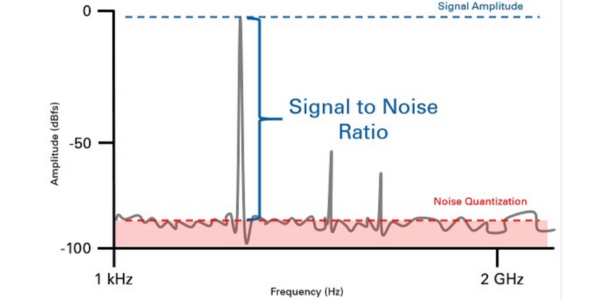
Theoretical Considerations
Noise Floor and Self-Noise
Every microphone and recording system has an inherent noise floor. In microphones, this internal noise—often termed self-noise—stems from:
- Thermal noise: Random electrical noise generated by the thermal agitation of electrons.
- Shot noise: Arising from the discrete nature of electrical charge.
- Circuit design limitations: Imperfections in preamplifiers, resistors, and other components contribute to extra noise.
The self-noise establishes a baseline below which a microphone cannot reliably record. Ideally, a microphone’s intended signal should be significantly above this noise floor. And hence it’s very important to select a good microphone as per your ambience noise.
Dynamic Range and Headroom
The dynamic range of a microphone or recording device is the span between its noise floor and the maximum signal it can capture before distortion (often referred to as “clipping”). SNR is closely related:
- A high SNR indicates an extensive dynamic range, allowing for the capture of both very quiet and very loud sounds without compromising the clarity of either.
- Headroom is the extra space above the nominal level to accommodate transient peaks. When combined with a high SNR, headroom ensures that unexpected spikes in the audio signal do not overwhelm the system.
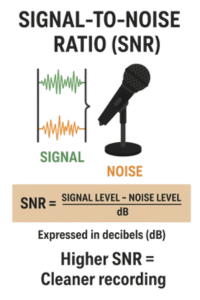
Practical Implications of SNR in Microphones
Audio Fidelity
- Clarity in Recordings: A high SNR minimizes the listener’s perception of background hiss or circuit noise, leading to a clean recording.
- Post-Production Flexibility: With less intrusive noise, audio engineers have more latitude to apply effects, dynamic range compression, or equalization without amplifying unwanted noise.
Applications Across Different Fields
- Broadcast and Voice-over Work: Here, intelligibility is paramount. Microphones with high SNR ensure that speech is crisp and free from distracting noise.
- Music and Studio Recording: For musical performances, even subtle ambient or instrumental details benefit from a high SNR, preserving the nuances and textures of instruments or vocalists.
- Field Recordings and Documentary: When recording in unpredictable environments, a high SNR helps in capturing the true atmosphere without the overlay of electronic noise.
Design Considerations in High-End Microphones
Manufacturers of premium microphones invest heavily in reducing self-noise by:
- Optimizing Internal Circuitry: Using low-noise components and designing circuits to minimize thermal and shot noise.
- Electromagnetic Shielding: Preventing interference from external electronic sources.
- Acoustic Engineering: Designing diaphragm and capsule geometries that maximize sensitivity to the desired sound while minimizing internal noise artifacts.
Advanced Topics Related to SNR
Noise Shaping and Filtering
Modern audio systems often incorporate noise shaping techniques to reduce the perceptual impact of noise. By selectively filtering frequencies where noise is most prominent (often in high frequencies where the ear is less sensitive), engineers can further improve the apparent SNR.
Digital Signal Processing (DSP) Enhancement
In digital recording and processing:
- Algorithms for Noise Reduction: Techniques such as spectral subtraction, adaptive filtering, and deep learning-based noise suppression are used to enhance SNR after the signal is captured.
- Bit Depth and SNR: The resolution of analog-to-digital converters (ADC) directly impacts the quantization noise, making high bit depths crucial for preserving SNR in digital recordings.
SNR in Different Environments
Environmental conditions can change the effective SNR during a recording session:
- Studio vs. Field Recording: Studios are controlled environments designed for high SNR, while field recordings often contend with ambient noises.
- Impact of Room Acoustics: Reverberation and ambient noise in a recording space can influence the effective SNR seen in the final signal.
Measuring and Improving SNR
Measurement Techniques
- Use of Calibrated Equipment: Measuring both the signal and the noise floor using standard calibrators or SPL meters.
- Spectral Analysis: Using a spectrum analyzer to visualize and quantify both the desired signal spectrum and the noise profile.
Practical Improvements
- Preamplifier Quality: Investing in high-quality, low-noise preamps can boost the effective SNR before any digital conversion.
- Optimized Gain Staging: Ensuring that the recording system is set up such that the signal is strong but not clipping, maximizing dynamic range.
- Environmental Considerations: Recording in acoustically treated spaces and minimizing external interference also contribute to a higher effective SNR.
Conclusion
A deep understanding of Signal-to-Noise Ratio is critical for anyone in the audio field. It’s not just about having a “high” dB number on a spec sheet; it’s about ensuring the purity and clarity of the captured sound. From the intrinsic electronic characteristics of microphones to the real-world challenges of recording environments, SNR plays a central role in shaping the audio landscape.
Whether you are designing a recording studio, choosing the right microphone for your project, or applying advanced digital processing techniques, a thorough grasp of SNR allows you to make informed decisions and achieve the best possible audio quality.


